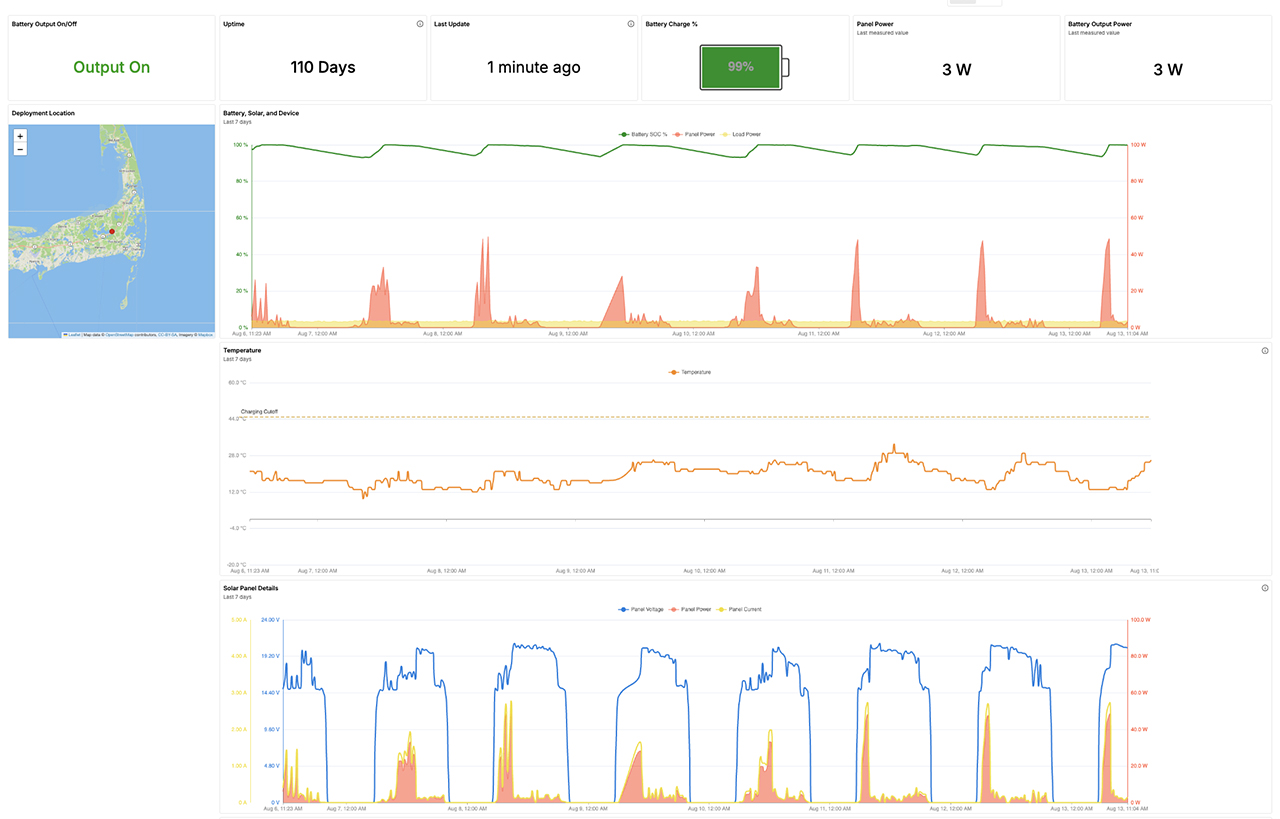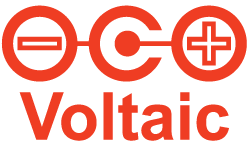

Voltaic receives requests for solar power when gateways and routers are being deployed where grid power is difficult to access, from parking lots in the middle of cities to riverbeds in remote areas.
Typical solar powered applications include LoRaWAN gateways connecting to a wide network of low power IoT devices like environmental sensors as well as cellular routers connecting high data rate devices like IP cameras or WiFi access points.
^back to topThere are three main components: solar panel, battery, and charge controller. Historically, a lead acid (AGM) battery is placed in a large, waterproof NEMA enclosure with the charge controller. Holes must be drilled to fit bulkheads or PG glands for the wiring in and out of the enclosure. AGM/SLA batteries are reliable, but they are heavy, bulky, and have limited cycles.
Voltaic’s CORE batteries were designed to address the wiring and mounting issues of an AGM in an enclosure. The CORE batteries integrate a battery and charge controller into a single waterproof enclosure. Lithium Iron Phosphate (LFP) cells significantly reduce the weight and size of the battery and increase the lifetime by 3-4 times compared to AGM.
Sizing is based on available sunlight in the worst months—December and January in North America and Europe.
The battery must be large enough to handle 4-10 days of bad weather (4 days in sunny places like Colorado and 10 days in cloudy places like London). The panel must be large enough to keep up with the gateway and have surplus power for recharging (typically 1.5 times the daily power consumption of the gateway/router system).
Voltaic has developed a solar sizing tool to help you quickly size your system. You can also schedule a consultation for sizing advice.
Most gateways list their power consumption on their spec sheet (under “DC Power Consumption”, etc.) They can list either “Typical” or “Maximum” power. It’s important to note that “Maximum” or “Peak” power is often a significant overestimate. “Typical”, “Average”, or “Idle” power consumption is usually more accurate, but it can still be high or low.
The best way to find your gateway or router’s power consumption is to measure it on the bench.
Voltaic can power most commercial gateways and routers consuming an average of 15 watts or less. The following chart summarizes popular gateways and their estimated power consumption. Bold indicates a measured value from our experience.
Selection of Popular Gateways for Solar
| Gateway | Connectivity | Power Consumption (W) | Physical Connectivity |
|---|---|---|---|
| Dragino DLOS8N | LoRaWAN | 1.8 | 5.5 x 2.1mm Connector |
| Kerlink Wirnet Station | LoRaWAN | 3 (5V) | PoE or 5V USBC |
| Milesight UG67 | LoRaWAN | 0.8 | M12 |
| Microtik LtAP LR8 | LoRaWAN | 4 | 5.5 x 2.1mm Connector |
| Multitech IP57 | LoRaWAN | 5.5 | PoE |
| Rak Wireless WisGate Edge Pro |
LoRaWAN | 6 | PoE |
| Seeed Studio SensCap |
LoRaWAN | 3.6 | M12 |
| Tektelic KONA Enterprise |
LoRaWAN | 4.5 | PoE |
| Teltonika TRB255 | LoRaWAN | 3 | 4 Pin Connector |
| Zenner IoT Gateway | LoRaWAN | 9 | PoE |
Selection of Popular Routers for Solar
| Router | Connectivity | Power Consumption (W) | Physical Connectivity |
|---|---|---|---|
| Cradlepoint IBR600C | WiFi / LTE | 4-9 | 4 Pin Connector |
| Milesight UR41 | LTE | 1-2 | 2 Pin Connector |
| Sierra Wireless Airlink RX55 |
WiFi / LTE | 1.4-3 | 4 Pin Connector |
| Sierra Wireless Airlink XR60 |
WiFi / LTE | 3.5 | 4 Pin Connector |
| Teltonika RUT241 | WiFi / LTE | 5-2.1 | 4 Pin Connector |
| Teltonika RUT956 | WiFi / LTE | 2-7 | 4 Pin Connector |
| Verkada GC31-E | LTE | - | 54V 6.5mm Connector |
Gateways and routers accept either PoE (Power over Ethernet) or DC power. DC is the more efficient of the two as there is significantly more voltage regulation with PoE. AC powered devices are typically not energy efficient for solar.
There are a variety of connectors—outdoor gateways are often waterproof and work through a bulkhead or PG gland. Outdoor cellular routers can require a waterproof enclosure and use a DC header or terminal block for power.

Milesight’s UR41 Router uses
an 8-pin header for power and I/O

Teltonika’s RUT241 uses
a clip-in 4-pin header for DC power

Dragino’s DLOS8N outdoor LoRaWAN gateway uses
a barrel jack via a waterproof bulkhead
PoE is often used in solar powered cellular router deployments that connect to a peripheral device like an IP Camera (security, license plate, etc.) or for gateways that only take PoE as a power source.
The issue is that most PoE injector and switches are not power efficient. Many of them consume as much power as the gateway they are powering.
Voltaic’s CORE batteries have the option to include a PoE injector inside of the battery that draws only 0.5W of self consumption. This can be the difference between a 50W and 100W solar panel for a gateway or router deployment.
The injector handles PoE/PoE+ (IEEE 802.3af/at). Waterproof ethernet bulkheads are included on the battery to make connection simple and easy.
^back to topOnce a solar gateway is deployed, it is helpful to know how it is performing. Is that battery charging to full most days? Is there a risk of the system running out of power?
Voltaic provides custom, high-quality solar power panels and mounting solutions.



